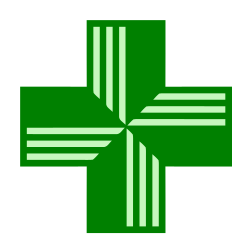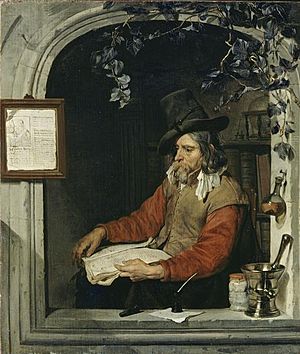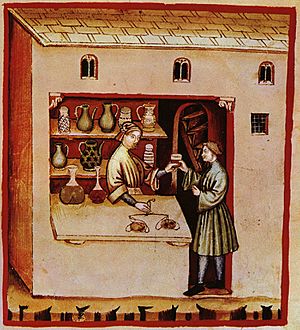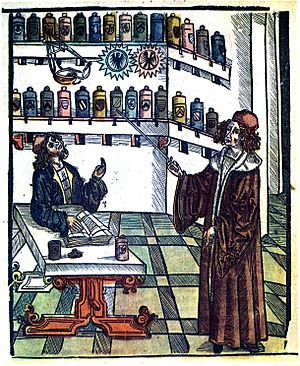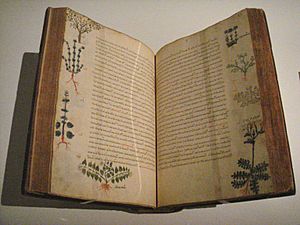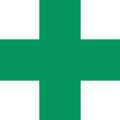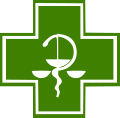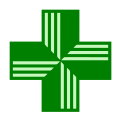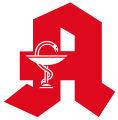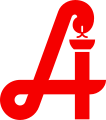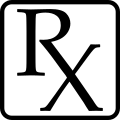Pharmacy facts for kids
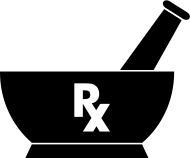 |
|
| Occupation | |
|---|---|
| Names | Pharmacist, Chemist, Doctor of Pharmacy, Druggist, Apothecary or simply Doctor |
|
Occupation type
|
Professional |
|
Activity sectors
|
Health care, health sciences, chemical sciences |
| Description | |
|
Education required
|
Doctor of Pharmacy, Master of Pharmacy, Bachelor of Pharmacy, Diploma in Pharmacy |
|
Related jobs
|
Physician, pharmacy technician, toxicologist, chemist, pharmacy assistant, other medical specialists |
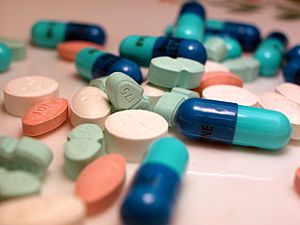
Pharmacy is a special field that combines science and practical work. It's all about finding, making, preparing, and giving out medications. The main goal is to make sure medicines are used safely, work well, and are affordable for everyone. Pharmacy connects health sciences with chemical sciences and natural sciences.
Today, many medicines are made by big companies. This means pharmacists are focusing more on helping patients directly. Pharmacists are experts in how medicines work. They are key health professionals who help people use their medicines in the best way.
A place where pharmacy is practiced is called a pharmacy or a chemist. In some places, like the United States and Canada, these shops are often called drugstores. They sell medicines, but also other things like snacks, makeup, and magazines. Long ago, people who prepared medicines were called apothecaries. Their work helped lead to modern chemistry and pharmacology.
Contents
What Pharmacy Includes
The field of pharmacy has several main parts:
- Pharmaceutics: This is about how medicines are made into forms people can use, like pills or liquids.
- Pharmacokinetics: This studies how the body handles a medicine. It looks at how the body absorbs, distributes, breaks down, and gets rid of drugs.
- Medicinal Chemistry and Pharmacognosy: Medicinal chemistry is about designing and making new medicines. Pharmacognosy is the study of medicines that come from natural sources, like plants.
- Pharmacy Practice: This is about how pharmacists actually help patients. It includes giving out medicines and advising people.
These different parts of pharmacy often work together. Pharmacists and other scientists team up to create new treatments. Pharmacology is also very important to pharmacy. It is the study of how medicines affect the body.
Another new area is Pharmacoinformatics. This uses computer science to help find and develop new drugs. It aims to make drug discovery faster and safer.
Pharmacogenomics looks at how a person's genes affect their response to medicines. This helps doctors choose the right medicine for each person.
Pharmacy Professionals
The World Health Organization (WHO) says there are at least 2.6 million pharmacists and other pharmacy staff around the world. These professionals play a vital role in healthcare.
History of Pharmacy
People have been using medicinal substances for thousands of years. One of the oldest known collections of medical knowledge is the Sushruta Samhita from India. It dates back to the 6th century BC. Ancient Sumerian clay tablets also show early prescriptions for medicines.
In Ancient Egypt, medical knowledge was written on papyrus scrolls. The Ebers Papyrus from 1550 BC is a famous example. It describes many ancient remedies.
In Ancient Greece, people like Diocles of Carystus studied plants for their healing powers. A Greek physician named Pedanius Dioscorides wrote a five-volume book in the 1st century AD. It was called De Materia Medica (Concerning Medical Substances). This book was used for centuries and influenced many scientists.
Pharmacy in China also has a long history. The Shennong Bencao Jing (The Divine Farmer's Herb-Root Classic) from the 1st century AD is an early Chinese manual. It lists many plant-based remedies.
In Japan, during the Asuka period (538–710), pharmacists were highly respected. They even had a higher rank than doctors in the Imperial court.
The first pharmacies, or drug stores, were set up in Baghdad in 754. This was during the Islamic Golden Age. By the 9th century, these pharmacies were regulated by the government. Scientists in the Middle East made big advances in botany and chemistry. They helped develop pharmacology greatly.
In Europe, pharmacy shops started appearing in the 12th century. In 1240, Emperor Frederic II made a rule. It said that doctors and apothecaries must be separate professions.
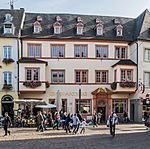
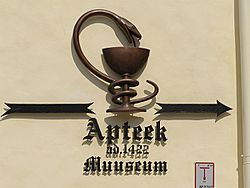
Some pharmacies in Europe have been open for hundreds of years. The Santa Maria Novella pharmacy in Florence, Italy, dates back to 1221. The Löwen-Apotheke in Trier, Germany, has been open since 1241. It is the oldest continuously operating pharmacy in Europe. In Dubrovnik, Croatia, a pharmacy opened in 1317. It is inside a Franciscan monastery and is still open today.
Where Pharmacists Work
Pharmacists work in many different places. These include local pharmacies, hospitals, clinics, and research centers. They also work for insurance companies and pharmaceutical companies. Some pharmacists specialize in certain areas of medicine.
Pharmacy in Society
What "Pharmacy" Means
The word pharmacy comes from an old French word, farmacie. This word came from the Greek word pharmakeia, meaning "a medicine". The Greek word pharmakon meant "drug, poison, or spell".
Doctors and Pharmacists: Separate Roles
In many parts of the world, doctors write prescriptions, and pharmacists give out the medicines. This is called "separation of prescribing and dispensing." In Western countries, this has been a tradition for centuries. In some Asian countries, doctors traditionally also give out medicines.
People debate whether it's better to separate these roles or combine them. Some say separating them helps prevent problems and lowers costs. Others say combining them does the same. Research shows different results depending on the situation.
Medicines and the Environment
In 2022, a group called the Organisation for Economic Co-operation and Development (OECD) suggested something important. They think drug companies should collect and destroy old or unused medicines. This would help reduce health risks from medicines thrown in the trash. It would also help stop bacteria from becoming resistant to antibiotics if they get into water systems.
Harmful amounts of medicine waste have been found in rivers around the world. The OECD suggests that medicines should be collected separately from regular trash. They also think there should be places to share unused medicines that are still good. Some countries, like France and Spain, already have programs for this.
The Future of Pharmacy
In the future, pharmacists will become even more important in healthcare. They won't just give out medicines. They will also be paid for their skills in patient care. This includes services like checking all the medicines a person is taking. This helps make sure medicines are used safely and effectively. It can also lower healthcare costs.
This change is already happening in some countries. For example, in Australia, pharmacists get paid to review medicines people take at home. In Canada, pharmacists in some areas can even prescribe certain medicines. In the United Kingdom, pharmacists with extra training can also prescribe. In the United States, many pharmacists now get a special degree called a Doctor of Pharmacy (Pharm. D.). They may also do extra training after graduation.
Pharmacists will also help people remember to take their medicines correctly. Studies show that pharmacy-based programs help patients stick to their medicine plans. This is especially true for people with long-term health conditions.
Symbols of Pharmacy
The most common symbols for pharmacy are the mortar and pestle (used in North America) and the ℞ symbol. This symbol is often written as "Rx" and means "prescription." In many European countries and India, a green Greek cross is used. The Bowl of Hygieia is also a common symbol, sometimes combined with other symbols.
Other symbols include conical measures (glass measuring tools). In Germany and Austria, a red stylized letter "A" is used. This comes from Apotheke, the German word for pharmacy. The show globe was used in the US long ago. The Gaper was used in the Netherlands but is now rare.
-
A green cross, often used for First Aid.
See also
 In Spanish: Farmacia para niños
In Spanish: Farmacia para niños


